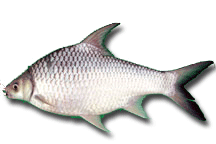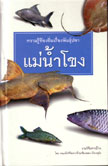Local Knowledge on Fish in the Mekong River
Thai Baan Research at Chiang Kong – Viang Kaen
By Thai Baan Research Team of Chiang Kong – Viang Kaen
Written by Sumart Phulaiyao.
Translated by Teerapong Pomun
 For the past decade, the Mekong River has been well known as an important international river because of its diversity and complication of ecosystems. Running through six countries, the river is called differently in areas it runs through. In Thai-Laos border area, locals in the Northern Thailand call it the Kong River. For the past decade, the Mekong River has been well known as an important international river because of its diversity and complication of ecosystems. Running through six countries, the river is called differently in areas it runs through. In Thai-Laos border area, locals in the Northern Thailand call it the Kong River.
People in the area rivers runs through get many different benefits from them. Some people do riverbank gardens, fishing, and take the river as a route. Rivers particularly this large river become a vital part of the lives along rivers.
For generations, people along the Mekong River have differently utilized the river. It becomes the livelihoods of sixty million people along the river. Local knowledge has accumulated from the dependence on the river. It is the knowledge that is written in lives and takes the whole life to gain. However, the knowledge sometimes gradually disappears. The reasons for this could be because there is no inheritor and it is not written.
Of the different local knowledge that is gradually disappearing, knowledge on fish and ecosystems is very important. It should be recorded for the next generation to learn and understand about the significance of natural resource conservation.
Knowledge can be recorded in different ways, but Chiang Kong- Viang Kaen villagers choose to record their knowledge in the form of “Jao Baan Research or Thai Baan Research.” In this way, the knowledge will be watched and protected from disappearance. The research, an alternative way of recording for the locals, was conducted to carry down the knowledge to the next generation.
Upper Thai-Laos border area from Kaeng Kon Pee Long in Chiang Kong district to Kaeng Par Dai in Viang Kaen district was selected as the study area. The research was conducted under five topics, fish species in upper Thai-Laos border area, ecosystems, plants, fishing gears, and social-culture. district was selected as the study area. The research was conducted under five topics, fish species in upper Thai-Laos border area, ecosystems, plants, fishing gears, and social-culture.
According to the finding on fish species, there are 96 fish species, 1 species of soft-shelled turtle, and 2 shrimp species in upper Thai-Laos border area. The villager researchers then categorize the fish species into two groups - rare and endangered species, and introduced species.
Rare and endangered species
It is found that there are 12 native fish species in the study area, which are Pla Buek (Mekong Giant Catfish), Pla Sua or Ern, Pla Ern, Pla Luem, Pla Sa Naak Paak Pid, Pla Kun, Pla Pueng, Pla Pha Mai, Pla Wa Hua Kum, Pla Wa Kam Tam, Pla Ka, Pla Sai, and Pla Suem.
These fish are put in this group because they have not been caught during the past five to thirty years. Three fish species that have not been caught in the past five years are Pla Buek (Mekong Giant Catfish), Pla Sai, and Pla Pha Mai. And the nine species that have not been catch in the past ten to thirty years are Pla Sua or Ern, Pla Ern, Pla Luem, Pla Sa Naak Paak Pid, Pla Kun, Pla Pueng, Pla Wa Hua Kum, Pla Wa Kam Tam, Pla Ka, and Pla Suem.
Pla Eian Hu (True eel) is rarely found in the area. Villagers do not know about this species and believe that it were great Naga fish. During 2002 to 2004, four True eels were caught. The weight of the biggest was six kilograms. According to Dr. Chavalit Vitthayanon, this species lays eggs in the deep sea between Vietnam and the Philippines before migrating into the Mekong River and its tributaries.
Introduced species
Of the 10 introduced fish species found in the Mekong River, some species are released into the river by the Department of Fisheries, for example, Pla Jean, Pla Sa Wai, Pla Nuan Jan, and Pla Ja La Med. Some get into the river from villagers’ fish ponds when the ponds are flooded. And some are unintended released into the river and its tributaries such as sucker fish.
The research finds that the 96 native species live in different sub-ecosystems, which some species are found in more than one sub-ecosystem. Fifteen species live in “Kaeng or Par”, fifteen species live in “Kwant”, twenty-four species live in “Kog”, nine species live in “Don” in the flooded season, twenty species live in “Had”, six species live in “Rong”, eight species live in “Long”, thirteen species live in “Nong”, two species live in “Jam”, fifty-one species live in “Houy” or tributary, and fifty-seven species live in the shallow areas along the riverside.
 The local knowledge gained from the research processes was collected, written, and published in “Local Knowledge on Fish in the Mekong River.” The book explains about the value of the Mekong River in a different way from mainstream or scientific knowledge. It is the way that locals can access and truly utilize. The local knowledge gained from the research processes was collected, written, and published in “Local Knowledge on Fish in the Mekong River.” The book explains about the value of the Mekong River in a different way from mainstream or scientific knowledge. It is the way that locals can access and truly utilize.
While the Mekong River is in changing direction and being developed, this book is a tool for affected locals to tell material developers from the outside that it is the time to place importance on local knowledge. This framework must be considered before any decision making on any development project that will impact community livelihoods.
The book on Jao(Thai) Baan Research “Local Knowledge on Fish in the Mekong River” could help us understand and learn the value of the Mekong River from the locals. The content of this book is full of the messages that locals who depend on the river want to tell about the importance of the nature and the respectability of Mekong ethnic groups. Moreover, local knowledge is a social space that we should raise in a public concern to save the richness of the river as it is the tenth longest river in the world. More importantly, it is protection of the river through the local knowledge under the philosophy “respect the nature and be faithful in human equality.” |

